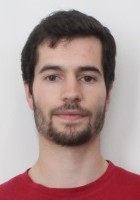
Gil Rocha received in 2016 his M.Sc. in Informatics and Computing Engineering (MIEIC) from the Faculty of Engineering of the University of Porto (FEUP). Currently, he is a PhD student at the Doctoral Program in Informatics Engineering (ProDEI) from FEUP. He conducts his research at the Artificial Intelligence and Computer Science Research lab (LIACC) at the Department of Informatics Engineering (DEI) from FEUP working on the topic of argumentation mining from text, supervised by Prof. Henrique Lopes Cardoso. He is a research member of the Argumentation Hub (ARGH), a multidisciplinary and collaborative lab on Argumentation, within the Media Innovation Labs (UPorto).
Rocha, G. and Lopes Cardoso, H. (2018). Recognizing Textual Entailment: Challenges in the Portuguese Language. Information, 9 (4), pp. 76
Rocha, G. and Cardoso, H. L. (2017). Towards a Relation-Based Argument Extraction Model for Argumentation Mining. International Conference on Statistical Language and Speech Processing (pp. 94–105)
Rocha, G. and Cardoso, H. L. (2017). Towards a Mention-Pair Model for Coreference Resolution in Portuguese. Portuguese Conference on Artificial Intelligence (pp. 855–867)
Rocha, G. and Cardoso, H. L. (2017). Recognizing textual entailment and paraphrases in Portuguese. Portuguese Conference on Artificial Intelligence (pp. 868–879)
Rocha, G. and Cardoso, H. L. (2017). Coreference Resolution in Portuguese: The Impact of Training Set Generation Approaches. Proceedings of the 12th Doctoral Symposium in Informatics Engineering – DSIE’17 (pp. 125-136)
Rocha, G. (2017). Argumentation Mining from Text Using Semantic Approaches. 18th EPIA Conference on Artificial Intelligence - Doctoral Symposium on Artificial Intelligence, SDIA 2017
Rocha, G. (2016). ArgMine: Argumentation Mining from Text. (Master’s Thesis, Department of Informatics Engineering, Faculty of Engineering, University of Porto)
Rocha, G., Lopes Cardoso, H. and Teixeira, J. (2016). ArgMine: a framework for argumentation mining. Computational Processing of the Portuguese Language-12th International Conference, PROPOR (pp. 13–15)

This member hasn't supervisions
